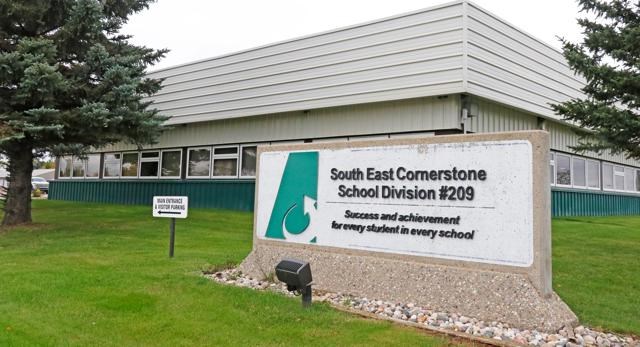If you don’t have a curriculum, you don’t have a school. It’s as simple as that.
Perhaps with that key component and concept in mind, the governing trustees of the South East Cornerstone Public School Division (SECPSD) were absorbed what Michael Graham had to say on Wednesday.
Graham is the curriculum co-ordinator for the sprawling SECPSD that embraces 37 school facilities plus a variety of other educational opportunities for approximately 8,300 students engaged in the learning processes from kindergarten to Grade 12.
Graham’s presentation to a mostly virtual/remote audience through an online public board session carried an interesting load of information they could absorb over the one hour allocated.
Graham is now in his fourth year of leading the curriculum and career development teams that include three on the curriculum side and seven on the career side of the educational equations.
He explained what the duties include and how they go about the process of assuring student success at various levels of their elementary to secondary school adventures.
The co-ordinator’s tasks include budget planning as well as rolling out reams of information regarding subject matter, resources and materials being made available and who delivers them.
He noted how such things as the Math Up program for kindergarten to Grade 8 students has been highlighted. The Ministry of Education-approved sessions provide various paths that can be used for lesson presentations, assessments of activities and consolidation.
Professional learning communities within the division, consisting of groups of teachers, take ownership of professional development opportunities, he explained. There are just five such groups this year, whereas in previous years there has been as many as 15 to 40. He noted the COVID pandemic situation had temporarily reduced this otherwise popular set up.
He said they group around such topics as student tasking, treaty education plans, French programming or handling multi-grade primary years classrooms.
Then there are collaborative – alike teams to support teachers during supplemental learning exercises. These teachers connect with others who have similar teaching roles, thus enhancing their skills while easing pressure on the individual educator.
There is a mentorship program as well, said Graham. There were just three applicants this year whereas in other years there might be as many as 12-15 new teachers, or veteran teachers entering new subject areas, seeking the mentorship and support of others who have been there.
Planning subject materials and delivery is a key ingredient so assistance is welcomed by all teachers, especially with the installation of a lot of virtual learning devices and techniques in the last part of the previous school year and continuing into this academic year.
The Student First program is a data driven sector and indicates continuous growth and improvement, he added.
Graham introduced Maryanne Kotylak in a virtual manner, noting she is now providing support of the burgeoning home-schooling program that now embraces 291 students, a 30 per cent increase over the previous school year, again, due in large part to the pandemic.
He said Kotylak has begun reading and math assessment programs and is planning a home-schooling learning fair.
The seven career development counsellors provide occupational advice and assist students entering into trades programs or seeking scholarships. The scholarship page, listing the 116 scholarships on the division’s web site has become popular with over 3,000 views since September.
Graham said Alameda-based Jeff Cameron is helping the division as a program facilitator as he plans career events and then facilitates them in association with the Regina and District Industry Education Council.
The Alternative Pathways programs give students options to seek careers as power engineers or agriculture equipment technicians, emergency responders. These are credited courses offered through partnerships with provincial corporations. They attracted 100 to 300 students yearly.
There are special credit courses now available in 16 schools in the division.
“Nine are completed and 56 more are projected to be completed,” said Graham, adding that there is a strong enrolment in these classes that offer three credits.
Apprenticeship courses offer four credits and eight schools have signed on to them with 22 courses completed and a further 19 projected to be completed.
“Last year there were just four schools involved,” said Graham, noting how interest has now doubled.
Career and Work credits is yet another program that offers four credits. This year shows 70 successful applicants earning credits with another 105 projected to achieve.
There are also credit recovery opportunities wherein a student is given a 30-day window in which to attempt to recover a credit or credits after a class ends. The causes are generally seen as missed classes or assignments, or a need to rewrite or revise following further instructions. He said 35 students have used this avenue to recoup credits.
Graham also noted that Raquel Oberkirsch, the First Nation, Métis and Inuit consultant, has been restricted to virtual lesson delivery so far and has been joined by Curtis Bourassa for social studies and treaty education activities that include Grade 7 and 8 building tasks in Minecraft.
“Raquel is also doing research projects for teachers doing work on treaty education in rural Saskatchewan,” Graham said.
A growth in French immersion programming has brought former ECS French instructor Lori Meyer into the fold as a consultant for the addition of French immersion in two elementary schools. The classes will be offered in Assiniboia Park Elementary School in Weyburn and Pleasantdale School in Estevan, beginning this September for kindergarten to Grade 2 students, and will move forward from that starting point. The current program in SECPSD offers French immersion in Estevan Comprehensive School as well as core French programs across the system in a variety of schools.
Also gaining ground and approval are curriculum renewal projects in the French and arts education areas and financial literacy courses, something new for nine schools in the division for students in Grades 7 -12.
So, as noted earlier, school isn’t just about readin’, ‘riting and ‘rithmetic these days.




